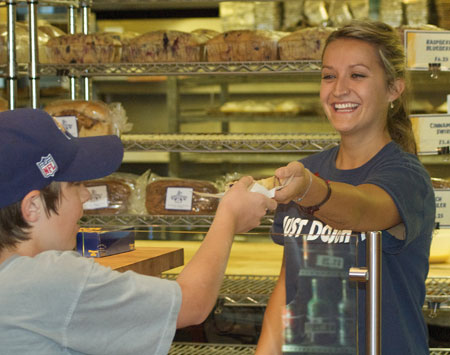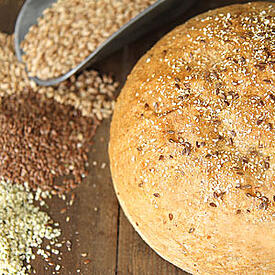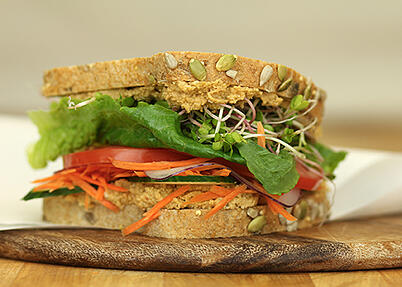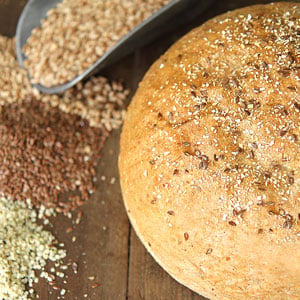Diabetes is a metabolic disease, meaning there is a glitch in the way the body converts food energy into usable energy. A healthy reaction to eating carbohydrate is a rise in blood sugar (glucose) followed by insulin being released as a response. The insulin acts as a key to open up cells within the brain and organs to let glucose in to be used as an immediate source of energy. Any unused energy is then stored in the liver, muscle, and fat tissues. Someone with diabetes has a rise in blood glucose but insulin is either not released or cells are resistant to the insulin. This is why diabetics have difficulty returning their high blood sugar levels back down to normal and thus need to control how much carbohydrate (glucose source) they put into their body throughout the day.
Control carbohydrates. With a little effort and control diabetes can easily be managed. Diabetics should not condemn, but rather control carbohydrates. They should focus on allowing their body only the amount of carbohydrates it can handle at one time (this can be determined by a doctor or registered dietitian). Despite being diabetic, the body still needs and uses carbohydrates as its preferred source of energy. In fact, it is the only source of fuel for the brain! So it should never be eliminated, just merely controlled so your body can handle the glucose load.

Stick to an eating plan. There is no single ideal eating plan for those with diabetes; the recommended plan is specific to a person’s weight, medication, blood sugars, cholesterol, and other medical conditions or concerns. Despite the varying eating plans, all diabetics should be consistent with their eating habits. Also, they need to eat about every 4-5 hours to prevent blood sugars from getting too low. Additionally, breakfast is an important meal not to miss so you can become energized and off to a good start for the day as it is the first bit of fuel you are ingesting after fasting overnight during sleep. It is also important that diabetics have a snack on hand if the time between their meals span greater than 4-5 hours. Pairing a carbohydrate with a protein or fat such as peanut butter on a slice of Dakota Bread, cottage cheese and fresh peaches, half of a turkey sandwich made with Honey Whole Wheat, or cheese and crackers are great options. It is best to eat a variety of different foods every day including lean protein and dairy, whole grains, fresh fruits and vegetables to get a full spectrum of nutrients! (See our free download for a sample eating plan.)
Make healthy carbohydrate choices. When choosing what carbohydrates to eat, try to stick with whole grains, fresh fruit, and dairy items like skim milk or low fat yogurt. It is recommended diabetics strive for whole grains as opposed to refined items as they are a nutrient rich option. The fiber content in whole  grains also slows digestion and thus slows the release of sugars into the blood stream. When carbohydrates need to be controlled, it is even more important they are nutrient dense. Healthy carbohydrate choices mean you can reap the benefits of fiber, vitamins, minerals, antioxidants, and phytochemicals while keeping calories under control!
grains also slows digestion and thus slows the release of sugars into the blood stream. When carbohydrates need to be controlled, it is even more important they are nutrient dense. Healthy carbohydrate choices mean you can reap the benefits of fiber, vitamins, minerals, antioxidants, and phytochemicals while keeping calories under control!
Watch serving sizes. A carbohydrate serving is 15 grams and a 2 oz slice of Honey Whole Wheat has 24 grams. That calculates out to about 1.5 servings of carbohydrate per slice. This means that making a sandwich with two slices of fresh Honey Whole Wheat Bread can provide around 3 servings of carbohydrates in a meal. Pair it with turkey, cheese, a little mustard and you have yourself a completely healthy and carbohydrate controlled meal.

Stay active. Physical activity is also very important in controlling diabetes and maintaining a healthy weight. Thirty minutes of moderate exercise most- if not all days is what diabetics, as well as the general public, should shoot for. Examples of moderate exercise include vigorous gardening, taking your bike for a cruise, or going on a brisk walk with a friend. So find a friend to briskly walk on over to your local Great Harvest Bakery so you can eat to your health and enjoy the whole grainy goodness of Great Harvest Breads!
Learn more about the diabetes and carbohydrate connection:





